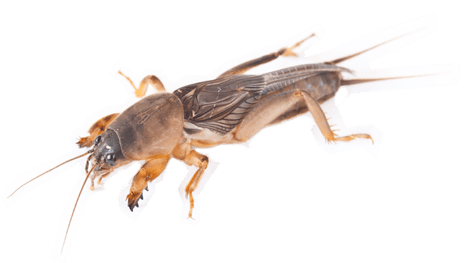Mole crickets are widely regarded as the most damaging insect pest in warm season turfgrass.
A Closer Look with Ian Rodriguez, Ph.D.

- Mole crickets are one of the most destructive turfgrass pests in the southern US. While there are as many as 10 species of mole crickets present in North America, the two most damaging to turfgrass are the tawny (Neoscapteriscus vicinus) and southern (Neoscapteriscus borellii) species. True to their name, these insects spend most of their lives underground and are strong tunnellers. Eggs hatch in late spring-early summer and the nymphs develop throughout the summer, molting as many as ten times. As they become larger over time, turf damage begins to become more apparent. Depending on the season and species, some mole crickets develop into adults by October while others will remain large nymphs through the winter months and mature the following spring.
- While both species feed on plant material, mostly roots, the majority of a southern mole cricket’s diet is carnivorous. They feed extensively on insects, including other mole crickets. Despite this, southern mole crickets are still very damaging to turf. With either species, while the loss of root mass can certainly contribute to drought stress and slowed growth, much of the injury/turf loss is caused by soil drying due to excessive tunnelling near the surface. Tunnels introduce air into the soil profile, dramatically increasing evaporation and loss of soil moisture. When activity is high, bulging tunnel trails and exit holes are visible, and the ground can feel very soft underfoot. To add insult to injury, digging animals such as armadillos, skunks, raccoons, and even birds may do additional damage to the turf in search of a cricket meal.
- Mole crickets can emerge from the surface at night in search of food, but adults with fully-formed wings can take flight either in search of new territory or mates. Flights typically occur in spring and fall. Spring flights precede the mating and/or egg laying periods. Crickets that mature by the fall may also fly to new areas prior to overwintering. Similar to other flying insects, mole crickets can be attracted to artificial light sources when on the move.
- Like many crickets, mole cricket males produce a species-specific mating call near the surface to attract a female. This has been taken advantage of by researchers over the years as a means of collecting mole crickets with “sound traps” mimicking the mating call on loudspeakers. Although effective, this method is not practical for most situations in terms of on-site monitoring. Managers can scout using a soap flush to drive nymphs to the surface where they can be counted.
- Speaking of scouting, using soap flushes to check for small nymphs is recommended when making a mole cricket IPM decision. As with other insect pests (and even weeds), mole crickets are most readily controlled when they are small and more susceptible to chemical applications. This not only allows for more control options, but prevents or avoids visible damage and turf loss from occurring several months later.
Subscribe to our website and follow Quali-Pro on Facebook & Twitter for promotions, product launches, product info and much more!

